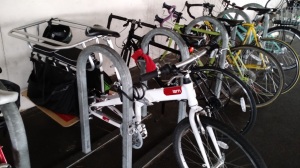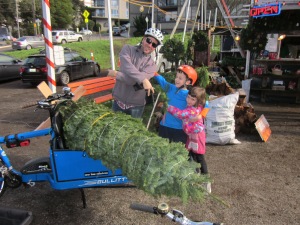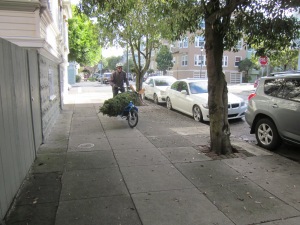
2 kids on deck with their feet in the bags and a stadium blanket. They’re kind of wusses.
People who see us around San Francisco may have already noticed that we have added a new cargo bike to our stable. Around when school started, we got an EdgeRunner. It’s fantastic.
I realize that we are in a fortunate position in being able to buy a second cargo bike outright. When we sold our minivan in 2012, we got enough money from it to buy two assisted cargo bikes. So we used about half of that money to buy the Bullitt, and we saved the rest for some vague future transportation need. At the time we weren’t sure whether we’d want to replace our car eventually, and figured the money we saved could be a nice down payment if it came to that. Two years later, we’ve found that we are just fine with renting cars for our very occasional driving trips, and have no desire to own one.
However we were feeling that it would be very helpful to have a second 2-kid capable cargo bike. The construction work in our garage smashed up the mamachari (RIP, mamachari), so we were suddenly down a bike. With two kids going to the same school for the first time this year, we were in the new position of wanting each parent to be able to pick up and drop off the kids together—before, we could split up because each of them was going to a different place at a different time. That was way more complicated, but it also meant that riding around on one-kid-hauling bikes wasn’t a big deal. Moreover, our son had become a strong enough rider that he was ready to go to school sometimes on his own bike. The problem with that was that the kids take a bus to their after-school program, and there are no bikes allowed on the bus. So if he was going to ride, we needed a way to get his bike from the drop-off at school to the pickup at after-school.
One option was to assist the Kona MinUte—because both kids are too heavy to haul around unassisted now—but it was a tight fit for two kids even when they were smaller, and left the question of how to haul our son’s bike unresolved. If you’re in the bike-on-bike-hauling business, your best bike is a longtail. We had taken enough test rides over the years to know that our favorite longtail, by a long shot, was the EdgeRunner. So around the time school started, we headed to The New Wheel to buy a BionX EdgeRunner. They were our bike shop of choice because they know so much about assists—anyone can take care of an unassisted bike, but having an electric assist-focused shop to maintain our bikes is an enormous luxury and it would be crazy not to take advantage of it. Also they are very nice. Even though we have to cross town and haul up serious hills to get there, which is not fun with kids when an assist is on the fritz, it is worth the effort.

This is Davey Oil’s stoked EdgeRunner with the same massive front rack.
Because I’ve gotten particular about certain things over the last couple of years, we put some unusual accessories on the bike as well. I credit G&O Family Cyclery for these particular specs, which I tried and loved on one of the EdgeRunners I rode while visiting Seattle to compare the BionX to the Stokemonkey. Specifically, we added a frame-mounted front rack and Rolling Jackass (very regrettable name) center stand from Haulin’ Colin in Seattle. The front rack was a huge pain to install, given that no one in San Francisco had done it before, and almost made me wish I’d flown my bike to Seattle instead of having the rack put on locally. But the payoff was a massive front basket (I have a Wald Giant basket zip-tied to the rack) that is independent of the steering and absolutely rock-solid, and that has easily swallowed loads like: my work tote, both kids’ backpacks, a clarinet, and a bag of groceries, with room for more. Finally, the EdgeRunner’s tiny rear wheel meant that I was getting a much bigger boost from the assist, which in my still-weakened state, meant that this was going to be my primary ride for a while.
The transition to riding the EdgeRunner with both kids was not without its issues. Our son doesn’t ride his own bike every single day, because he tends to go at a maximum speed of 7mph, making even my normal pace look like road racing. When we leave home on the later end of normal, we have to stick him on the trailer-bike to make it to school on time, and that means I’ll end up carrying both kids home in the afternoon. Although both kids easily fit on the EdgeRunner’s deck, for the first two weeks sharing the deck they fought so relentlessly that I actually found myself yelling, “I can stop this bike right here!” I am happy to report that this was a short-term problem—they eventually settled down, and now they usually have pleasant conversations sitting face-to-face during the times that they share the deck. The only remaining annoyance is that our long-legged son will drag his feet on the ground sometimes, which acts as an unwelcome extra brake and does his shoes no favors. He’s getting better about this.

Loading up my son’s bike for the tow.
There are compensations. The biggest is that when he does ride, it is laughably easy for me to tow his bike to work in the morning, and to his after school program in the afternoon before riding home. It has definitely reduced our load and is improving his stamina (and although he doesn’t like to admit it yet, he’s in a much better mood when he rides to school and back home). The bike can also haul unusual loads that were formerly pretty tricky. When I had to pick him up from school a couple of weeks ago because he’d gotten sick, I had no trouble towing the bike while he was nodding off on the deck. That kind of doubling-up has historically been the Bullitt’s weakness.
Our daughter is our primary deck-rider, though. The EdgeRunner deck has a bit more space for a kid than the Bullitt, but it is also uncovered. This has led to some complaints about having to experience weather, and some excitement. We have a Hooptie around the deck, and given our daughter’s personality, that was a smart move. She treats the deck as a combination small room and performance space, and kind of does what she feels like doing back there. Sometimes that’s lying down flat to take a nap. Sometimes that’s standing on the deck on one tiptoe while holding onto my shoulders. Sometimes that’s leaning waaaaaaaaay over to one side to check out something on the ground (at which point I once again feel a sense of gratitude for that low deck, because I can feel her doing it but it doesn’t dump the bike). The EdgeRunner is our mullet bike: business in front, party in the back. Our daughter has been a frequent flyer in the hospital emergency department since she was less than a year old, thanks to her try-everything attitude , which means that we have more experience assessing what constitutes a serious physical risk to her than we ever wanted. I’ve learned not to worry about her shenanigans, because her balance is excellent, she’s corralled by the Hooptie, our route consists of quiet streets and protected lanes, and I’m usually riding at (much) less than 10mph behind my son. However I definitely get a lot of drive-by parenting. I mean that literally. People in cars pull up next to us and tell me to tie her down, sometimes pointing to their own kids strapped in 5-point restraints in car seats as examples. I am already so over this. And I have begun to wonder, from a philosophical perspective, what it says about us as a society that our kids spend so much time literally tied down.
I digress.

Seriously, these bikes are all over San Francisco now. These are the racks at my office.
Riding an EdgeRunner is also fun because it makes me to feel like I joined a club. Although it gets a lot of attention from people who don’t ride bikes, it is definitely the bike of choice among San Francisco parents (along with the Yuba Mundo). As one might expect, most of them are BionXed up as well. There are two EdgeRunners on the Panhandle riding to school most mornings, and I see a blue one just like mine almost every day, coming the opposite way on Post Street after I’ve dropped off the kids. There sometimes yet another EdgeRunner, with a Yepp seat, parked at the racks at my office. After a couple of years riding the Bullitt, which raises eyebrows wherever it goes and has tourists snapping photos, the relative obscurity of riding an EdgeRunner is a nice change of pace.
Most importantly, it does what we need it to do. The addition of the EdgeRunner means that Matt and I can each ride a cargo bike that can haul both kids, and/or their bikes, wherever we’re going. Even though the BionX is not the most powerful assist you can put on a bike, we have used it to get up the hills of Bernal Heights with both kids on the deck. That’s steeper than we ever hope to go on a daily basis. And with the regenerative braking it has crazy-range–I sometimes feel as though I’ve returned home with the same charge I had when I left.
We came late to having two big cargo bikes, but it’s been working well for us. Having two kids in the same school has allowed our schedules to ease enormously, and having two big bikes to haul them and their bikes around as needed makes it easier still. Our son may be slow when riding his own bike, but we’re still beating our old car commute times. I’ve heard a lot of people say that having a box-bike and a longtail is the perfect two-cargo bike situation. Based on our experience so far, I’d have to agree.



















